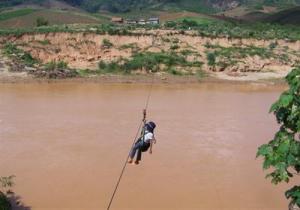Concerns Arise Over Dak Nong Commune’s Unique Form of Transport

For several years now, residents of Dak Nong Commune (Đắk Nông) in Kon Tum have relied on the 150-meters long cable stretched about 20 meters above Po Ko River as their only means to cross the dangerous waters and get to the other side to be able to work, go to school, and reach the marketplace.
The river separating the commune from Ho Chi Minh Road used to be narrower during the previous years and ferry boats were widely used to cross the distance. Storms and floods caused the water to expand significantly and the two opposite banks became much higher than the water surface. Crossing it on-board a ferry boat became virtually impossible and climbing its high banks is as equally undoable. With the rough waters capable of overturning boats, reaching the other side by boat or swimming is never considered anymore by the people as an option.
The area used to have a chain bridge but it was swept away by floods. The commune’s officials were planning to rebuild it, but with the district’s limited capabilities, everyone knows the project will take a considerable amount of time. It is also said that the state had set aside a budget for a multi-billion project to have a strong-structured bridge across Po Ko River along the sections belonging to Dak Ang Commune. Apart from the project not materialized yet as of the moment, the proposed bridge does not offer so much convenience for the residents even when it is completed. Its location would require villagers to walk a distance of 6 kilometers to get the bridge, cross the bridge, then walk another 6 kilometers to their residences.
Desperate for ways of quick transport, the idea of sliding across a cable with the use of a pulley attached to it became the solution to the residents’ problem. They believe that even when the bridge is completed, they would still prefer the half-a-kilometer long cable which takes only 10 seconds to get to the other side versus walking a total distance of 12 kilometers. All households in the commune contributed money to materialize the project and sometime in 2007, the cable was completely set up across Po Ko.
Since then, the cables mounted on three places along the river had become their most convenient mode of transport to get to the other side of Dak Ang Commune. And people from Dak Ang travel back to Dak Nong to reach the Ho Chi Minh Road nearby and get to schools and markets. Over time, the acrobatic stunt they have to perform everyday had become a way of life for the villagers in this part of Vietnam. Even children as young as second-graders, armed with heavy books in their schoolbag, have gotten themselves used to hanging on to that pulley while gliding through the cable.
Being the only way to get to school, looks like these kids have little choice but to accustom themselves to it. However, many admit that their only means of transport is never safe. In fact, a number of accidents have occurred in the past when the cable accidentally snapped or people slip their hands from the pulley causing serious injuries to a number of villagers. The most recent and probably among the scariest incidents is when a local police officer was sliding across the cable holding his daughter when the pulley broke off. Both the father and daughter fell into the river, the rushing water sweeping away the little child while the father was knocked unconscious as the broken pulley hit him on the head. Locals from nearby was able to retrieve the child and along with her father, was confined in the hospital for the necessary treatments.
Apart from the indeed very primitive way to travel, the most concern is centered on how this daily activity of villagers from this area have placed hundreds of lives at risk for several years now, and unless something is done, these people will have to live with that risk. With the commune’s low budget, they acknowledge the need for financial support from upper authorities to have this matter taken into account. Hopefully, with the entire country made aware of this, more help will come in and soon, the villagers can work easily and children can go to school safely.









